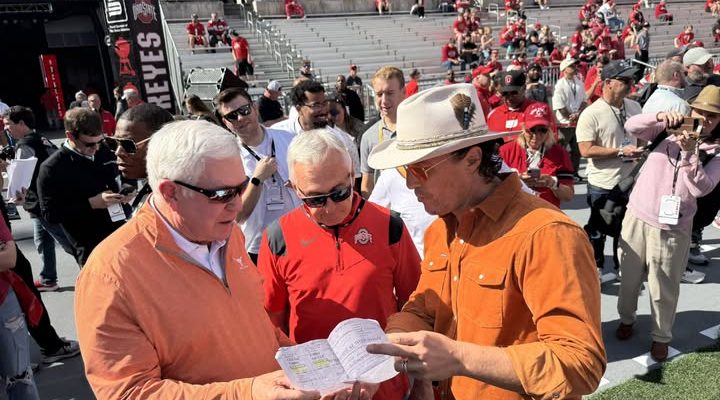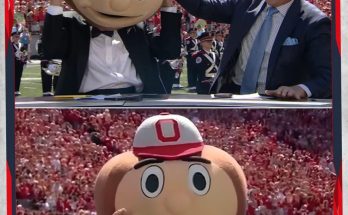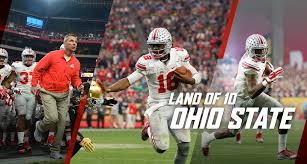On a night that already carried the weight of history, tradition, and high-stakes football, the presence of three iconic figures elevated the atmosphere to something almost mythical. Mack Brown, Jim Tressel, and Matthew McConaughey—all giants in their own ways—were spotted in the building as the Texas Longhorns prepared to take on the Ohio State Buckeyes. Each represents a different era, a different story, and a different chapter in the broader tapestry of college football and culture. Yet, together in one place, their appearance underscored just how much this matchup meant not only to the two programs involved but to the sport itself. This was no ordinary game, and the electric energy flowing through the stadium was amplified by the symbolic presence of legends who had shaped football and culture in ways few could have imagined.
For Mack Brown, stepping into a game of this magnitude meant revisiting both triumphs and challenges. The former Texas head coach, who famously led the Longhorns to the 2005 national championship after an epic battle against USC, is synonymous with Texas football greatness. His calm demeanor, football wisdom, and ability to recruit and inspire some of the game’s best athletes remain part of his lasting legacy. Seeing him in the building wasn’t just nostalgia—it was a reminder of when Texas football stood atop the college landscape, embodying dominance and resilience. Fans who grew up in the golden Vince Young era looked at Brown as more than a coach; he was a builder of dreams, a figure who captured the state’s football pride and gave it national glory. His presence was both inspiring and sobering, reminding Longhorn fans of the program’s potential while also highlighting the long and winding journey back to national relevance.
On the opposite sideline of history stood Jim Tressel, the former Ohio State head coach whose career was defined by discipline, structure, and an unwavering focus on fundamentals. Tressel was no stranger to pressure-packed environments like this. He guided the Buckeyes to the 2002 national championship and shaped a culture that would define Ohio State football for decades. Known as “The Senator” for his polished demeanor and meticulous game management, Tressel’s approach was different from Brown’s but equally effective. For Buckeye fans, seeing Tressel in the building rekindled memories of his iconic wins, his dominance in Big Ten play, and his ability to prepare his teams for colossal battles. His legacy is complex, with his career shadowed by NCAA infractions, but in the world of Ohio State faithful, he remains an iconic figure whose contributions are undeniable. His appearance at this game wasn’t just about being a spectator; it was about symbolically passing the torch to the present, reminding everyone of the traditions, victories, and standards Ohio State football holds itself to.
Then there was Matthew McConaughey—the Hollywood actor, Academy Award winner, and lifelong Texas Longhorns superfan. More than just a celebrity on the sidelines, McConaughey has become something like the spirit animal of Texas football, embodying the charisma, confidence, and swagger that the program so often projects. His presence isn’t quiet or subtle. Whether it’s delivering emotional pre-game speeches to fire up the players or bringing his unmistakable charisma into the locker room, McConaughey has long been a part of the Texas fabric. His love for the burnt orange isn’t performative—it’s passionate, consistent, and deeply personal. When cameras panned to him in the stands, it wasn’t just about celebrity star power. It was about the connection between entertainment, culture, and sport, all converging in one of the most anticipated games of the season. For Texas fans, having McConaughey in the building was a reminder that their team and their culture resonate far beyond the football field—they are a cultural movement in themselves.
The convergence of these three figures created a unique narrative. Mack Brown represented Texas’ glorious past, a coach who proved the Longhorns could stand atop the mountain. Jim Tressel represented Ohio State’s enduring standard of success, a coach who instilled discipline and consistency that helped mold the Buckeyes into a perennial powerhouse. Matthew McConaughey represented the cultural heartbeat of Texas football, reminding everyone that this game, this program, and this rivalry mattered on a deeper level. Together, their presence sent the message that this matchup between Texas and Ohio State wasn’t just another Saturday night showdown—it was an event layered with meaning, history, and resonance that transcended the game itself.
Inside the stadium, the energy was palpable. Fans from both sides roared as the teams warmed up, but when the cameras found Brown, Tressel, and McConaughey, the crowd erupted in acknowledgment. Social media lit up instantly, with fans and analysts alike posting about the surreal image of seeing those three icons in the same space. Commentators couldn’t help but highlight the symbolism: one man who gave Texas its modern national championship, another who gave Ohio State its first title of the 2000s, and a cultural icon who has brought attention to the Texas program in ways statistics never could. Their combined presence turned an already massive game into a cultural phenomenon, adding weight to every snap, every call, and every moment of action.
The players themselves had to have felt it. Imagine being a young quarterback, stepping out onto the field with the knowledge that the very men who once defined college football greatness were in the building, watching, evaluating, perhaps silently nodding in approval. The pressure to perform was already immense given the stakes of Texas vs. Ohio State, but with figures like Brown and Tressel in attendance, the sense of legacy became undeniable. For the Longhorns, it was about showing McConaughey and Brown that the current generation could restore Texas pride. For the Buckeyes, it was about proving to Tressel that the foundation he built continues to flourish under the bright lights.
Beyond the immediate impact on fans and players, the moment carried broader implications. College football thrives on tradition, legacy, and the larger-than-life figures who have shaped its history. To have Brown and Tressel in the same building reminded the world that college football is a sport deeply rooted in legacy. To have McConaughey there showed how the sport has grown into a cultural spectacle that transcends sports itself. This convergence highlighted what makes college football unique—its ability to bring together history, celebrity, and competition in one unforgettable moment.
As the game unfolded, every shot of the three in attendance served as a kind of punctuation mark on the narrative. When the Longhorns made a big play, the cameras flashed to McConaughey, his signature grin lighting up the screen. When the Buckeyes responded, Tressel’s stoic expression filled the broadcast, symbolizing Ohio State’s resilience. And when the game seemed to reach moments of peak tension, Mack Brown’s calm, knowing demeanor reminded everyone that he had lived through and thrived in such moments before. Their presence became as much a part of the spectacle as the game itself, intertwining with the action on the field in a way that elevated the entire experience.
After the final whistle, regardless of the result, the significance of their presence lingered. Fans leaving the stadium talked not only about the plays, the touchdowns, or the mistakes, but also about seeing Brown, Tressel, and McConaughey together. It became part of the game’s lore, one of those stories that fans will retell years later: “Remember that night Texas played Ohio State and Mack Brown, Jim Tressel, and Matthew McConaughey were all there?” In that way, their presence became inseparable from the story of the game itself.



